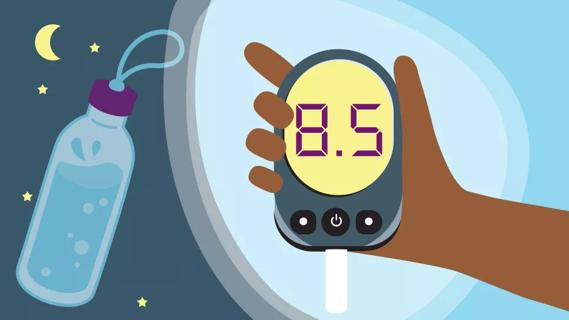This short-term diet is for those who want to lose a significant amount of weight quickly

In the world of diets, it can be overwhelming with the choices available — keto, paleo, flexitarian, just to name a few.
Advertisement
Cleveland Clinic is a non-profit academic medical center. Advertising on our site helps support our mission. We do not endorse non-Cleveland Clinic products or services. Policy
But for those trying to lose a lot of weight, the protein-sparing modified fast diet, or the PSMF diet, may be a good short-term option.
Doctors typically recommend this diet for a person who has obesity. And you should be supervised by a doctor or registered dietitian while on the PSMF diet.
So, how does the PSMF diet work? By consuming low amounts of calories and carbohydrates and high amounts of protein, the idea is that weight loss happens quickly.
“It’s a modified keto,” says registered dietitian Beth Czerwony, RD. “The majority of your calories are going to come from protein. There’s very minimal fat and your options include lean protein with limited vegetables. You won’t eat fruits, starchy vegetables, breads or pastas. And this will help your body go into ketosis, which is a fat-burning mode.”
Czerwony explains how the PSMF diet works and its pros and cons.
The PSMF diet is divided into two phases: The intensive phase and the refeeding phase.
During the intensive phase, which typically lasts about six months, you’ll eat about 800 calories per day. The goal is to consume about 0.7 grams of protein per pound of your body weight.
When it comes to carbs, you’ll want to eat about 20 grams or less a day — with those carbs coming from vegetables. You’ll also need to avoid any added fats that come from foods like oils and salad dressings.
Advertisement
“Most of the time, people stay on it on average of about six months because they get bored, they get tired or they want some variety,” says Czerwony.
Your doctor or dietitian will monitor any nutritional deficiencies and may recommend that you take magnesium, potassium and/or sodium supplements.
“We asked people to salt their foods to make sure that their blood pressure doesn’t get too low,” says Czerwony.
Once you’ve reached your weight loss goal, then you’ll begin the maintenance part of the diet known as the refeeding phase.
“This is over several weeks of slowly adding carbohydrates back into your diet,” explains Czerwony. “And the idea is to get a more balanced intake, to stop that ketosis and to help you maintain the weight that you’ve lost. Ideally, you’ll stay on the maintenance phase indefinitely.”
While on the PSMF diet, you’ll eat mostly high-protein foods like:
You can also eat non-starchy vegetables like leafy greens, broccoli, tomatoes, onions, cabbage and celery.
There are foods you’ll need to avoid like:
Here are some benefits and drawbacks of the PSMF diet:
For a person who has obesity, the PSMF diet could be a good option to lose a certain amount of weight.
But a reminder that it’s best to undergo this diet while under the supervision of your doctor or dietitian.
Studies show that a low-calorie diet like the PSMF diet may lower blood sugar levels in those with Type 2 diabetes.
“We see improvements in blood sugar control because of the limited carbohydrates,” says Czerwony. “So, if you have high glucose numbers you may see an improvement.”
Studies also show that by consuming fewer calories, your blood pressure may be reduced.
“We see improvement in hypertension a lot of times because it’s directly related to weight,” notes Czerwony.
Advertisement
The PSMF diet is very restrictive when it comes to what you can eat, what you can’t and how many calories you can consume. It can be difficult for people to maintain long-term.
“What we find is that most people just get bored with it. Or they go on a vacation or to a party and they eat something that has carbs in it and it takes them out of ketosis, so then they have increased hunger,” says Czerwony. “Then, it’s hard for them to get back into ketosis, so they kind of fall off the wagon.”
Those with medical conditions like Type 2 diabetes, high blood pressure, gout and kidney problems should avoid the PSMF diet, unless it’s medically supervised.
“If you already have a history of gout, since it’s such a high protein diet, you might be more likely to have a flare-up. And because it’s such a high protein diet, we don’t want to overtax the kidneys,” states Czerwony.
Part of the process when it comes to weight loss means you’re likely to lose some of your muscle mass.
“That’s because as you’re losing weight there’s less of you, so you’re not burning as many calories even walking because you don’t have that resistance,” explains Czerwony. “Hopefully, by consuming enough protein, it will protect your muscles. Physical activity is something that is part of that program to maintain your muscles and healthy fat metabolism.”
Advertisement
It’s easy to become dehydrated while on the PSMF diet. That’s why Czerwony says it’s key to drink at least 64 ounces of fluids daily and that you salt your foods.
“We call it the keto flu — it’s really just a shift in fluid status,” says Czerwony. “You may become nauseous or experience headaches and dizziness.”
That dehydration can also lead to constipation — and high-protein diets are known to cause it as well.
“That’s because you’re eating limited vegetables and that can lead to muscle cramping, which happens if your electrolytes are off,” Czerwony explains. “We want to make sure that you’re taking all your supplements as well.”
You may have to adjust your budget while on the PSMF diet. As most of the diet is high-protein foods like lean meats, your grocery bill can add up quickly.
“Traditional protein alternatives like beans and lentils aren’t allowed and those options tend to be a bit more budget-friendly,” says Czerwony.
So, is the PSMF diet worth a try? It’s up to each person, says Czerwony.
You may want to talk to your doctor about other options like anti-obesity medication or even bariatric surgery.
“Your doctor should consider your long-term goals,” says Czerwony. “The problem a lot of times is that people will do this diet and they’re very successful the first time. Then fast-forward a couple of months or years and they want to do it again. They’re not as successful the second time.”
Advertisement
And this isn’t the right diet if you just want to lose a few pounds.
“It’s not necessary to try something as extreme,” says Czerwony. “You should cut out excessive calories, whether that’s from sugary beverages or fried foods. Also, look at your physical activity and increase that as well.”
Learn more about our editorial process.
Advertisement

Planning ahead, checking in with your care team and being vigilant about blood sugar monitoring can help ensure a safe fast

It’s best to exercise before or after your fast, instead of during it

Plan ahead by hydrating, cutting back on sugar and managing medications

Fasting can significantly impact your hormones — proceed with caution

An expert breaks down how and why people try it

A cardiologist's perspective on pros and cons of fasting

'Early time-restricted feeding' can produce health + weight-loss benefits

The short answer from a registered dietitian

Type 2 diabetes isn’t inevitable with these dietary changes

Applying a hot or cold compress can help with pain